Idea of mole and chemical counting
1 like263 views
This presentation from www.gyanbikash.com provides math examples for fractions for students in classes nine to ten, showing 3/12 equals 0.25 and 8/6 equals 1.33. It concludes with a message thanking the viewers and saying goodbye.
1 of 29





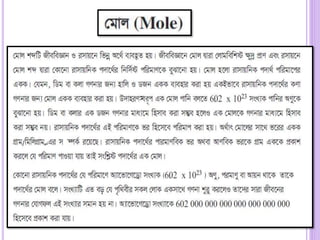
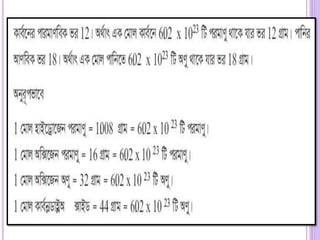


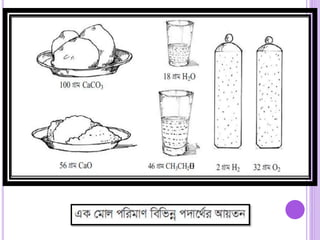
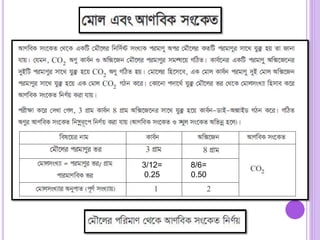
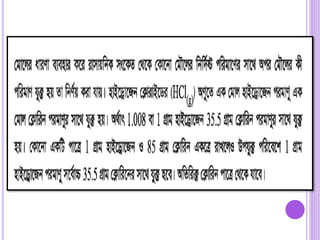
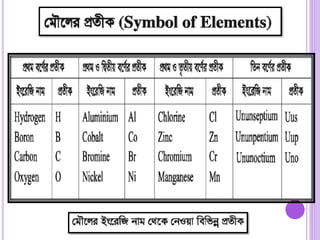
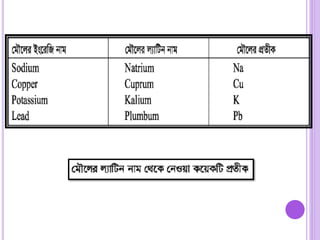
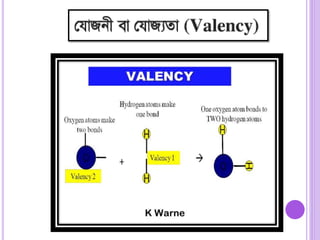
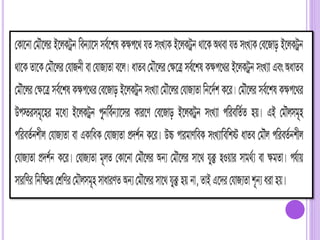

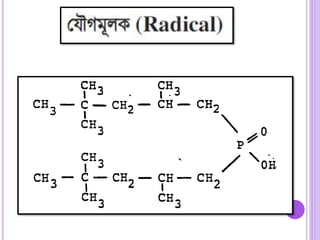
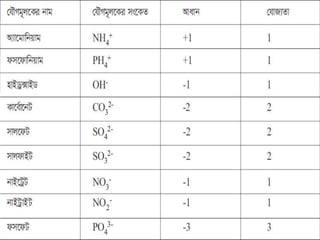


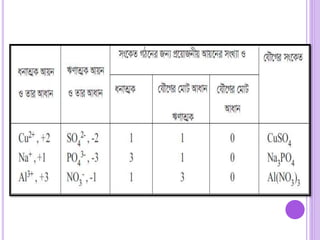



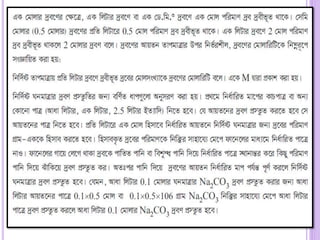



Ad
Recommended
Percentage Bonding
Percentage BondingGyanbikash
Ìı
This 3 sentence summary provides the key information from the document:
The document welcomes viewers to the website gyanbikash.com and states that the presentation is made for students in classes nine to ten. It then says "That's all for today" and thanks the viewers while saying goodbye.Oxidation reduction
Oxidation reductionGyanbikash
Ìı
This presentation introduces addition reactions to students in classes nine to ten. It begins with a welcome message and information about the presenting organization, www.gyanbikash.com. It concludes with a thank you and goodbye message after covering the topic of addition reactions.Hratch Semerjian, CCR: Lean and Clean: Equipping Modern Manufacturers
Hratch Semerjian, CCR: Lean and Clean: Equipping Modern Manufacturersguest3e1229f
Ìı
The document discusses the importance of sustainable manufacturing in the U.S. chemical industry, emphasizing the need for innovation and investment to improve energy efficiency and reduce environmental impacts. It outlines the significant economic contributions of the chemical sector and highlights research and development as crucial for long-term competitiveness. Proposed investments aim to yield substantial reductions in fossil fuel use and greenhouse gas emissions while generating new jobs and revenue.Dr. Ahmad Abdul Hay Agwa - Offshore drilling waste treatments & risk manageme...
Dr. Ahmad Abdul Hay Agwa - Offshore drilling waste treatments & risk manageme...promediakw
Ìı
The document discusses offshore drilling waste and risk management. It defines drilling mud and cuttings, and outlines the regulations around offshore drilling waste discharges. It then describes various treatment methods for drilling mud and cuttings, including thermal, biological and chemical treatments. Newer techniques like cuttings re-injection and advanced zero discharge treatment systems are also covered. The goal is to minimize waste discharges by maximizing treatment and reuse of materials.Renewable energy from polymer
Renewable energy from polymer srikanthgadam
Ìı
1) Dielectric elastomers are promising materials for artificial muscles and can be used to generate power from mechanical energy through their elastic properties and ability to store and release electrical energy.
2) When stretched, dielectric elastomers store mechanical energy that can be converted to electrical energy upon contraction if connected to a load. Research is optimizing this process for applications like power generation from human motion or ocean waves.
3) The electrical energy generated is proportional to the square of the applied voltage and the ratio of contracted to stretched dimensions. DARPA has demonstrated heel-strike generators producing up to 0.8J per step, with potential for 1W average power from walking. EAPSeminar 2009
Seminar 2009rare_rare
Ìı
The document discusses various physical treatment methods for hazardous industrial wastes, including electrodialysis, reverse osmosis, adsorption, and distillation. Electrodialysis uses ion exchange membranes and an electric current to separate ions from solutions. Reverse osmosis uses pressure to force a solution through a semi-permeable membrane, retaining dissolved solutes on one side. Adsorption utilizes the ability of gases or liquids to accumulate on surfaces like activated carbon. Distillation separates mixtures based on differences in volatility through boiling and condensation.Careers in Chemical engineering
Careers in Chemical engineeringTMI Group
Ìı
The document provides information about chemical engineering - what it entails, its history, applications and future opportunities. It describes chemical engineering as applying scientific principles to design and develop structures, machines and processes to convert raw materials into useful products. The history of chemical engineering traces back to the 19th century with the rise of industrial scale manufacturing. Today, chemical engineers work in diverse fields like pharmaceuticals, fertilizers, polymers and more. The document also outlines the skills required for chemical engineering and typical career paths and roles after graduation.Offshore drilling
Offshore drillingAhmed Ehab
Ìı
The document discusses offshore drilling in the United States. It provides details on the history and locations of offshore drilling in the US. Offshore drilling produces a significant portion of US oil and gas. However, it also faces regulatory restrictions and debates around various costs and environmental concerns. The document also discusses the US partnership with Brazil to help develop offshore drilling capacity there.My Future Job Chemical Engineer
My Future Job Chemical Engineerguestcb2213
Ìı
Chemical engineering is a career focused on the industrial applications of chemistry, requiring a bachelor's degree and skills in math and science. Chemical engineers typically work in laboratories, offices, or manufacturing plants and have the potential for promotions and salaries starting at around $60,000 per year. The field is growing, and reading and writing skills are essential for documenting experiments and solutions.What Is Chemical Engineering
What Is Chemical Engineeringguestaf4b064
Ìı
Chemical engineering involves various disciplines like petrochemical, pharmaceutical, and environmental engineering. A chemical engineer's work environment can include companies like Shell, AstraZeneca, and Scotts. While the number of chemical engineers declined slightly from 2010 to 2018, average earnings range from $54,000 to $130,000. Chemical engineering differs from chemistry in that engineers apply research to develop useful products while chemists focus more on laboratory research.Chemical engineering and future aspects(vikas verma)
Chemical engineering and future aspects(vikas verma)vikas249
Ìı
Chemical engineering originated over 100 years ago due to the need for chemical processors during the Industrial Revolution. It grew out of mechanical engineering and involves applying principles of chemistry, physics, biology and math to efficiently and safely convert raw materials into useful products through continuous processing. Modern chemical engineering has expanded beyond process engineering to include developing high-performance materials for applications like aerospace, automotive, biomedical and more through interdisciplinary fields like biomedical engineering. The field of chemical engineering continues to grow as it plays a key role in innovation and mass production across many industries.RECYCLING OF WASTE IN CHEMICAL AND OTHER INDUSTRIES,FLY ASH ...
RECYCLING OF WASTE IN CHEMICAL AND OTHER INDUSTRIES,FLY ASH ...Gowri Prabhu
Ìı
1) The document discusses recycling and utilization of industrial waste and fly ash. It describes different types of hazardous waste generated by various industries like chemical, printing, vehicle maintenance etc. and methods of recycling these wastes.
2) Methods of recycling discussed include recycling of sulfuric acid, hydrochloric acid, polymers and plastics through processes like sorting, chopping, washing, drying etc. Recycling of metals like iron and steel is also described.
3) The uses of fly ash from coal combustion in applications like cement, soil stabilization, waste treatment and brick manufacturing are highlighted. Recycling helps conserve resources and reduces pollution.Oil & Gas industry Waste Management
Oil & Gas industry Waste Managementmamdouh sabour
Ìı
The document discusses waste management in the oil and gas industry. It identifies several types of waste generated including tank bottom sludge, spill cleanup materials, municipal solid waste, and hazardous waste. It provides objectives to identify challenges in sustainable waste management and compare factors affecting waste management in developed versus less developed oil areas. The document then discusses various waste management strategies like reduction, reuse, recycling, and treatment and applies them to specific waste streams from oil and gas facilities.Waste as a future feedstock - James clark
Waste as a future feedstock - James clarkEllenMacArthurFoundation
Ìı
The document discusses the importance of green chemistry in transforming waste into valuable feedstock for future manufacturing, highlighting the sustainability challenges within the chemical industry. It emphasizes the need for efficient resource management, consumer awareness, and education in green chemistry principles to prepare the workforce for emerging job opportunities in this field. Additionally, it outlines various initiatives and collaborations aimed at advancing green practices and renewing the industry's approach to sustainability.Treatment of resin waste water Ppt
Treatment of resin waste water PptManish Kumar
Ìı
The document discusses treatment of wastewater from resin manufacturing industries using coagulation-flocculation. It begins with an introduction to resins, their types and uses. It then discusses the coagulation and flocculation processes and mechanisms. Literature review covers various studies on treatment of wastewater from different industries like textile, distillery using different coagulants. It also discusses characteristics of wastewater from phenol formaldehyde and ABS resin industries. The objectives of the work are to characterize the wastewater and optimize treatment process using composite coagulants to remove pollutants like acrylonitrile, COD, BOD, TSS. Comparison of different treatment systems for acrylonitrile containing wastewIndian Chemical Industry
Indian Chemical IndustryVeeraj Vashishtha
Ìı
The Indian chemical industry is estimated at $35 billion and accounts for 13-14% of India's exports and 8-9% of imports. It has an annual growth rate of 10% and manufactures a wide range of chemicals including petrochemicals, inorganic chemicals, agrochemicals, and pharmaceuticals. However, the industry faces high costs of power and finance compared to other countries as well as a need for improved infrastructure, technology, and scale of production.Paper & pulp industry by er. sanyam s. saini (me regular) (2012-14)
Paper & pulp industry by er. sanyam s. saini (me regular) (2012-14)Sanyam Singh
Ìı
The document provides an overview of the paper industry. It discusses that paper is made from wood or recycled fibers by separating them into pulp. India's paper industry converts wood or agro residues into paper. The key steps in paper making involve preparing and pulping raw materials, washing and bleaching pulp, processing it on a paper machine, and drying the final paper product. The industry impacts the environment through air emissions and solid wastes generated during pulping, bleaching, and paper production.Water Pollution Control in Pulp and Paper Industry
Water Pollution Control in Pulp and Paper IndustryVaibhav Nautiyal
Ìı
The document provides an overview of water pollution control in the pulp and paper industry in India, highlighting its high water consumption and pollution levels due to outdated technology and processes. It details various waste management techniques, pollution prevention programs, and treatment methods employed in the industry. Additionally, it emphasizes the need for modernization through improved R&D investments, cleaner production techniques, and resource recovery to enhance environmental sustainability.Off Shore Oil Drilling Presentation
Off Shore Oil Drilling PresentationChristian Ricchezza
Ìı
The document discusses the environmental impacts of offshore oil drilling and oil spills. It describes the multi-step process of locating and drilling for offshore oil reserves, which includes seismic surveying that uses sound waves to map underground resources but can harm marine mammals. Offshore drilling produces toxic waste waters and cuttings that pollute the environment. Major oil spills like the Deepwater Horizon and Exxon Valdez disasters caused widespread damage to wildlife like birds, sea turtles, and marine mammals from oil coating and ingestion. Oil pollution has long-lasting impacts by persisting in the environment and disrupting food webs.Treatment of waste from pulp industry
Treatment of waste from pulp industryprarthana mary
Ìı
The document summarizes treatment methods for waste from the pulp and paper industry. It describes the various sources and characteristics of effluents from pulp and paper production. It then outlines the typical treatment scheme, including screening to remove solids, sedimentation to settle out particles, biological treatment using aerobic and anaerobic microorganisms, and tertiary treatments like ozonation or membrane filtration to remove additional contaminants. The goal is to reduce COD, BOD, color, and other pollutants before releasing the treated water.Chemical Engineer Intro presentation
Chemical Engineer Intro presentationJMangan33
Ìı
Chemical engineering involves taking courses in calculus, chemistry, physics, and biology. During training, common courses include process control, materials, thermodynamics, biomaterials, and bioengineering. A bachelor's degree is required to work as a chemical engineer, where problem solving is a key part of designing, developing, producing, selling, or managing in fields like chemicals, fuels, food, drugs, aerospace, and the environment. Notable companies that employ chemical engineers include DuPont, known for achievements like Kevlar body armor and Tyvek sheets, and Bristol-Myers Squibb, where engineers work on fighting diseases. Some influential historical chemical engineers include Waldo Semon, who invented tires, PVCIndian Chemical Industry Challenges and Opportunities
Indian Chemical Industry Challenges and OpportunitiesResurgent India
Ìı
The Indian chemical industry significantly contributes to the national economy, accounting for approximately 2.51% of GDP and expected to grow to USD 214 billion by 2019. Despite being the third-largest producer of chemicals in Asia, India depends on imports due to demand outpacing domestic production capacity. Key challenges include logistical support, raw material procurement, and regulatory reforms, but with strategic investments and policy support, India has potential to become a global manufacturing hub.Indian chemical industry
Indian chemical industryPallavi Todankar
Ìı
The chemical industry in India has evolved significantly since independence in 1947. Some of the earliest chemical factories after independence included Bengal Chemicals in Kolkata, the Sindri fertilizer plant in Rajasthan, and a small petroleum refinery in Assam. Currently, the Indian chemical industry contributes around 3% to India's GDP and 11% of total industrial output. It is also a significant export industry, contributing around 10% of India's total exports. The industry has major segments including inorganic chemicals, drugs and pharmaceuticals, petrochemicals, pesticides, fertilizers, and specialty/fine chemicals. Major players in these segments include companies like Reliance Industries, Haldia Petrochemicals, RanIndustrial waste
Industrial wasteSarita Dhal
Ìı
This document discusses sources and impacts of industrial water pollution. It notes that industrial waste from sources like steel, food, and chemical industries introduces pollutants like heavy metals, acids, alkalies, oils, and petrochemicals into water bodies. These pollutants can harm aquatic life and contaminate fish. The document also examines offshore oil drilling as a source of water pollution through drilling fluids, oil spills, and other discharges. Oil pollution damages marine organisms and can disrupt food chains. Proper environmental assessment and use of biodegradable drilling fluids can help control pollution from offshore drilling.Industrial waste management
Industrial waste management Awad Albalwi
Ìı
Industrial waste management principles and practices
The document discusses principles and practices for industrial waste management, including reduce, reuse, recycle, treatment, and disposal. It provides examples of each, such as redesigning products to use fewer materials, extending product lifespan, recycling scrap metal, and using deep injection wells for frack waste disposal. The overall aim is to explore solutions for industrial waste and implement waste management systems and principles in organizations.Pulp and Paper industry
Pulp and Paper industryArun Sarasan
Ìı
The document outlines the pulp and paper industry's processes, from converting raw materials to manufacturing paper, highlighting the environmental challenges such as waste and emissions. It discusses the evolution of pulping technologies, particularly the kraft method, and emphasizes the industry's significant water use and energy consumption. The text also explores cleaner production measures, including genetic modifications of trees and recycling efforts aimed at reducing environmental impact and improving sustainability.Conversion of waste plastic into fuel
Conversion of waste plastic into fuelNational Institute of Technology, Hamirpur
Ìı
This document describes the process of converting waste plastic into fuel through pyrolysis. Pyrolysis involves thermally degrading plastic in the absence of oxygen to produce solid, liquid, and gaseous fuels. The process uses a specially designed reactor heated to 350°C along with catalysts to cause the random depolymerization of plastics into fuel products. The machine used in pyrolysis consists of a reactor, catalytic cracker containing ZSM-5 zeolite catalyst, condenser to liquefy vapors, and nitrogen cylinder to provide an inert atmosphere. Converting waste plastic to fuel through pyrolysis solves disposal issues while producing valuable energy sources.State Of Element
State Of ElementGyanbikash
Ìı
This presentation introduces several scientific concepts for students including the states of matter of salt, water, and carbon dioxide as solid, liquid, and gas respectively. It demonstrates the physical changes of ice melting into water and water evaporating into vapor. Experiments are described such as a balloon test to observe molecules and the difference between diffusion and effusion. Other topics covered include candle burning and the cooling curve of water. The presentation concludes with thanking the students.Speacial chemical reaction
Speacial chemical reactionGyanbikash
Ìı
This short presentation was created by the website www.gyanbikash.com to provide information for students in classes nine and ten. It welcomed the viewers to the site and thanked them at the end of the brief presentation. The presentation aimed to help students in classes nine and ten.Periodic Table
Periodic TableGyanbikash
Ìı
This document provides an introduction to the French chemist Antoine Lavoisier who lived from 1743 to 1794. It mentions that he created a table of elements in 1789 when only 33 elements were known. The document concludes by thanking the viewer and saying goodbye.More Related Content
Viewers also liked (19)
My Future Job Chemical Engineer
My Future Job Chemical Engineerguestcb2213
Ìı
Chemical engineering is a career focused on the industrial applications of chemistry, requiring a bachelor's degree and skills in math and science. Chemical engineers typically work in laboratories, offices, or manufacturing plants and have the potential for promotions and salaries starting at around $60,000 per year. The field is growing, and reading and writing skills are essential for documenting experiments and solutions.What Is Chemical Engineering
What Is Chemical Engineeringguestaf4b064
Ìı
Chemical engineering involves various disciplines like petrochemical, pharmaceutical, and environmental engineering. A chemical engineer's work environment can include companies like Shell, AstraZeneca, and Scotts. While the number of chemical engineers declined slightly from 2010 to 2018, average earnings range from $54,000 to $130,000. Chemical engineering differs from chemistry in that engineers apply research to develop useful products while chemists focus more on laboratory research.Chemical engineering and future aspects(vikas verma)
Chemical engineering and future aspects(vikas verma)vikas249
Ìı
Chemical engineering originated over 100 years ago due to the need for chemical processors during the Industrial Revolution. It grew out of mechanical engineering and involves applying principles of chemistry, physics, biology and math to efficiently and safely convert raw materials into useful products through continuous processing. Modern chemical engineering has expanded beyond process engineering to include developing high-performance materials for applications like aerospace, automotive, biomedical and more through interdisciplinary fields like biomedical engineering. The field of chemical engineering continues to grow as it plays a key role in innovation and mass production across many industries.RECYCLING OF WASTE IN CHEMICAL AND OTHER INDUSTRIES,FLY ASH ...
RECYCLING OF WASTE IN CHEMICAL AND OTHER INDUSTRIES,FLY ASH ...Gowri Prabhu
Ìı
1) The document discusses recycling and utilization of industrial waste and fly ash. It describes different types of hazardous waste generated by various industries like chemical, printing, vehicle maintenance etc. and methods of recycling these wastes.
2) Methods of recycling discussed include recycling of sulfuric acid, hydrochloric acid, polymers and plastics through processes like sorting, chopping, washing, drying etc. Recycling of metals like iron and steel is also described.
3) The uses of fly ash from coal combustion in applications like cement, soil stabilization, waste treatment and brick manufacturing are highlighted. Recycling helps conserve resources and reduces pollution.Oil & Gas industry Waste Management
Oil & Gas industry Waste Managementmamdouh sabour
Ìı
The document discusses waste management in the oil and gas industry. It identifies several types of waste generated including tank bottom sludge, spill cleanup materials, municipal solid waste, and hazardous waste. It provides objectives to identify challenges in sustainable waste management and compare factors affecting waste management in developed versus less developed oil areas. The document then discusses various waste management strategies like reduction, reuse, recycling, and treatment and applies them to specific waste streams from oil and gas facilities.Waste as a future feedstock - James clark
Waste as a future feedstock - James clarkEllenMacArthurFoundation
Ìı
The document discusses the importance of green chemistry in transforming waste into valuable feedstock for future manufacturing, highlighting the sustainability challenges within the chemical industry. It emphasizes the need for efficient resource management, consumer awareness, and education in green chemistry principles to prepare the workforce for emerging job opportunities in this field. Additionally, it outlines various initiatives and collaborations aimed at advancing green practices and renewing the industry's approach to sustainability.Treatment of resin waste water Ppt
Treatment of resin waste water PptManish Kumar
Ìı
The document discusses treatment of wastewater from resin manufacturing industries using coagulation-flocculation. It begins with an introduction to resins, their types and uses. It then discusses the coagulation and flocculation processes and mechanisms. Literature review covers various studies on treatment of wastewater from different industries like textile, distillery using different coagulants. It also discusses characteristics of wastewater from phenol formaldehyde and ABS resin industries. The objectives of the work are to characterize the wastewater and optimize treatment process using composite coagulants to remove pollutants like acrylonitrile, COD, BOD, TSS. Comparison of different treatment systems for acrylonitrile containing wastewIndian Chemical Industry
Indian Chemical IndustryVeeraj Vashishtha
Ìı
The Indian chemical industry is estimated at $35 billion and accounts for 13-14% of India's exports and 8-9% of imports. It has an annual growth rate of 10% and manufactures a wide range of chemicals including petrochemicals, inorganic chemicals, agrochemicals, and pharmaceuticals. However, the industry faces high costs of power and finance compared to other countries as well as a need for improved infrastructure, technology, and scale of production.Paper & pulp industry by er. sanyam s. saini (me regular) (2012-14)
Paper & pulp industry by er. sanyam s. saini (me regular) (2012-14)Sanyam Singh
Ìı
The document provides an overview of the paper industry. It discusses that paper is made from wood or recycled fibers by separating them into pulp. India's paper industry converts wood or agro residues into paper. The key steps in paper making involve preparing and pulping raw materials, washing and bleaching pulp, processing it on a paper machine, and drying the final paper product. The industry impacts the environment through air emissions and solid wastes generated during pulping, bleaching, and paper production.Water Pollution Control in Pulp and Paper Industry
Water Pollution Control in Pulp and Paper IndustryVaibhav Nautiyal
Ìı
The document provides an overview of water pollution control in the pulp and paper industry in India, highlighting its high water consumption and pollution levels due to outdated technology and processes. It details various waste management techniques, pollution prevention programs, and treatment methods employed in the industry. Additionally, it emphasizes the need for modernization through improved R&D investments, cleaner production techniques, and resource recovery to enhance environmental sustainability.Off Shore Oil Drilling Presentation
Off Shore Oil Drilling PresentationChristian Ricchezza
Ìı
The document discusses the environmental impacts of offshore oil drilling and oil spills. It describes the multi-step process of locating and drilling for offshore oil reserves, which includes seismic surveying that uses sound waves to map underground resources but can harm marine mammals. Offshore drilling produces toxic waste waters and cuttings that pollute the environment. Major oil spills like the Deepwater Horizon and Exxon Valdez disasters caused widespread damage to wildlife like birds, sea turtles, and marine mammals from oil coating and ingestion. Oil pollution has long-lasting impacts by persisting in the environment and disrupting food webs.Treatment of waste from pulp industry
Treatment of waste from pulp industryprarthana mary
Ìı
The document summarizes treatment methods for waste from the pulp and paper industry. It describes the various sources and characteristics of effluents from pulp and paper production. It then outlines the typical treatment scheme, including screening to remove solids, sedimentation to settle out particles, biological treatment using aerobic and anaerobic microorganisms, and tertiary treatments like ozonation or membrane filtration to remove additional contaminants. The goal is to reduce COD, BOD, color, and other pollutants before releasing the treated water.Chemical Engineer Intro presentation
Chemical Engineer Intro presentationJMangan33
Ìı
Chemical engineering involves taking courses in calculus, chemistry, physics, and biology. During training, common courses include process control, materials, thermodynamics, biomaterials, and bioengineering. A bachelor's degree is required to work as a chemical engineer, where problem solving is a key part of designing, developing, producing, selling, or managing in fields like chemicals, fuels, food, drugs, aerospace, and the environment. Notable companies that employ chemical engineers include DuPont, known for achievements like Kevlar body armor and Tyvek sheets, and Bristol-Myers Squibb, where engineers work on fighting diseases. Some influential historical chemical engineers include Waldo Semon, who invented tires, PVCIndian Chemical Industry Challenges and Opportunities
Indian Chemical Industry Challenges and OpportunitiesResurgent India
Ìı
The Indian chemical industry significantly contributes to the national economy, accounting for approximately 2.51% of GDP and expected to grow to USD 214 billion by 2019. Despite being the third-largest producer of chemicals in Asia, India depends on imports due to demand outpacing domestic production capacity. Key challenges include logistical support, raw material procurement, and regulatory reforms, but with strategic investments and policy support, India has potential to become a global manufacturing hub.Indian chemical industry
Indian chemical industryPallavi Todankar
Ìı
The chemical industry in India has evolved significantly since independence in 1947. Some of the earliest chemical factories after independence included Bengal Chemicals in Kolkata, the Sindri fertilizer plant in Rajasthan, and a small petroleum refinery in Assam. Currently, the Indian chemical industry contributes around 3% to India's GDP and 11% of total industrial output. It is also a significant export industry, contributing around 10% of India's total exports. The industry has major segments including inorganic chemicals, drugs and pharmaceuticals, petrochemicals, pesticides, fertilizers, and specialty/fine chemicals. Major players in these segments include companies like Reliance Industries, Haldia Petrochemicals, RanIndustrial waste
Industrial wasteSarita Dhal
Ìı
This document discusses sources and impacts of industrial water pollution. It notes that industrial waste from sources like steel, food, and chemical industries introduces pollutants like heavy metals, acids, alkalies, oils, and petrochemicals into water bodies. These pollutants can harm aquatic life and contaminate fish. The document also examines offshore oil drilling as a source of water pollution through drilling fluids, oil spills, and other discharges. Oil pollution damages marine organisms and can disrupt food chains. Proper environmental assessment and use of biodegradable drilling fluids can help control pollution from offshore drilling.Industrial waste management
Industrial waste management Awad Albalwi
Ìı
Industrial waste management principles and practices
The document discusses principles and practices for industrial waste management, including reduce, reuse, recycle, treatment, and disposal. It provides examples of each, such as redesigning products to use fewer materials, extending product lifespan, recycling scrap metal, and using deep injection wells for frack waste disposal. The overall aim is to explore solutions for industrial waste and implement waste management systems and principles in organizations.Pulp and Paper industry
Pulp and Paper industryArun Sarasan
Ìı
The document outlines the pulp and paper industry's processes, from converting raw materials to manufacturing paper, highlighting the environmental challenges such as waste and emissions. It discusses the evolution of pulping technologies, particularly the kraft method, and emphasizes the industry's significant water use and energy consumption. The text also explores cleaner production measures, including genetic modifications of trees and recycling efforts aimed at reducing environmental impact and improving sustainability.Conversion of waste plastic into fuel
Conversion of waste plastic into fuelNational Institute of Technology, Hamirpur
Ìı
This document describes the process of converting waste plastic into fuel through pyrolysis. Pyrolysis involves thermally degrading plastic in the absence of oxygen to produce solid, liquid, and gaseous fuels. The process uses a specially designed reactor heated to 350°C along with catalysts to cause the random depolymerization of plastics into fuel products. The machine used in pyrolysis consists of a reactor, catalytic cracker containing ZSM-5 zeolite catalyst, condenser to liquefy vapors, and nitrogen cylinder to provide an inert atmosphere. Converting waste plastic to fuel through pyrolysis solves disposal issues while producing valuable energy sources.More from Gyanbikash (20)
State Of Element
State Of ElementGyanbikash
Ìı
This presentation introduces several scientific concepts for students including the states of matter of salt, water, and carbon dioxide as solid, liquid, and gas respectively. It demonstrates the physical changes of ice melting into water and water evaporating into vapor. Experiments are described such as a balloon test to observe molecules and the difference between diffusion and effusion. Other topics covered include candle burning and the cooling curve of water. The presentation concludes with thanking the students.Speacial chemical reaction
Speacial chemical reactionGyanbikash
Ìı
This short presentation was created by the website www.gyanbikash.com to provide information for students in classes nine and ten. It welcomed the viewers to the site and thanked them at the end of the brief presentation. The presentation aimed to help students in classes nine and ten.Periodic Table
Periodic TableGyanbikash
Ìı
This document provides an introduction to the French chemist Antoine Lavoisier who lived from 1743 to 1794. It mentions that he created a table of elements in 1789 when only 33 elements were known. The document concludes by thanking the viewer and saying goodbye.Mineral treasure-Fossil
Mineral treasure-FossilGyanbikash
Ìı
This presentation introduces students to concepts like gasoline, bitumen, and alkane uses. It was created by www.gyanbikash.com for class 9-10 students to learn about these chemical topics. The presentation covers gasoline, bitumen, uses of alkanes, and concludes with thanks and goodbye.Finding the place of atom on periodic table from electron distribution
Finding the place of atom on periodic table from electron distributionGyanbikash
Ìı
This presentation introduces electron distribution in atoms, focusing on periods 2 and 3 of the periodic table. It discusses how electrons are arranged in shells and provides information about halogens. The presentation concludes by thanking the audience and saying goodbye.Different useful things and washing soap
Different useful things and washing soapGyanbikash
Ìı
This presentation introduces various chemical concepts and terms for students including ammonia producing plants, quick lime, spreading Uriah, potassium sorbet, and sodium sorbet. The presentation comes from the website www.gyanbikash.com and is intended for students in classes nine to ten.Concept of ph
Concept of phGyanbikash
Ìı
This presentation introduces students to pH meters and how they are used to measure acidity and alkalinity. It was created by the website www.gyanbikash.com for students in classes nine and ten. The presentation covers pH meters and then concludes after thanking the students for their time.Changing condenced ore on oxide
Changing condenced ore on oxideGyanbikash
Ìı
This presentation introduces students to various metals and materials including acidic flux, steel, stainless steel, and gold bars. It was created by www.gyanbikash.com for students in classes nine to ten. The presentation covers multiple topics but provides little detail on each.Structure of element
Structure of elementGyanbikash
Ìı
This presentation introduces students to various chemical elements like boron, nitrogen, and magnesium. It also mentions taking a technetium injection. The presentation concludes by thanking the students and saying goodbye.Nuclear model
Nuclear modelGyanbikash
Ìı
This presentation introduces students to scientists Earnest Rutherford and Neil Bohr and Bohr's model of the atom. It begins with welcoming the students and introducing the presenting organization. It then provides brief information about Rutherford and Bohr's contributions to understanding atomic structure, specifically Bohr's model of the atom. It concludes by thanking the students and saying goodbye.Mineral treasures ( metal nonmetal)
Mineral treasures ( metal nonmetal)Gyanbikash
Ìı
This presentation introduces various minerals and compounds found in the earth's crust, including salt, diamond, bauxite, magnetite, and FeWO4. It is intended for students in classes nine and ten to teach them about important geological resources. The presentation concludes by thanking the viewers and saying goodbye.Idea of chemistry
Idea of chemistryGyanbikash
Ìı
This presentation introduces chemistry and its applications in daily life. It shows symbols related to alchemy and chemistry, such as the symbol of the alchemist. It also depicts ways chemistry is used, including in making soap and detergent, using insecticides in farming, with aerosol sprays, and pasteurization. The presentation concludes with thanking the audience.Equality of acid and base
Equality of acid and baseGyanbikash
Ìı
This short presentation introduces the website gyanbikash.com and is intended for students in classes nine to ten. It discusses litmus paper and then concludes by thanking the viewers and saying goodbye.Electrochemical cell
Electrochemical cellGyanbikash
Ìı
This short presentation was created by the website www.gyanbikash.com to provide information for students in classes nine and ten. It welcomed the viewers to the site and thanked them at the end of the presentation for their time.Covalent bonding
Covalent bondingGyanbikash
Ìı
This presentation introduces students to various chemical compounds including methane, ammonia, carbon dioxide, and sodium chloride. It was created by the website www.gyanbikash.com to educate students in classes nine and ten. The presentation covers these essential compounds and then concludes by thanking the viewers.Chemistry in daily life
Chemistry in daily lifeGyanbikash
Ìı
This presentation introduces common household items like baking powder, yeast, laundry soap, and detergent. It was created by www.gyanbikash.com for students in classes nine and ten. The presentation covers these everyday products and then concludes by thanking the viewers.Chemistry and Energy
Chemistry and EnergyGyanbikash
Ìı
This short presentation was created by the website www.gyanbikash.com to provide information for students in classes nine and ten. It welcomed the viewers to the site and thanked them at the end, signing off by saying goodbye.Chemical reaction
Chemical reactionGyanbikash
Ìı
This short presentation was created by the website www.gyanbikash.com to provide information for students in classes nine and ten. It welcomed the viewers to the site and thanked them at the end, signing off with "Goodbye".Chemical Bonding
Chemical BondingGyanbikash
Ìı
This presentation introduces various types of ionic bonding found in different compounds for students in classes nine to ten. It discusses the ionic bonding of magnesium oxide, calcium chloride, and potassium chloride as examples. The presentation concludes by thanking the students and saying goodbye.Base and basic
Base and basicGyanbikash
Ìı
This short presentation was created by the website www.gyanbikash.com to provide information for students in classes nine and ten. It welcomed the viewers to the site and thanked them at the end of the brief presentation. The presentation aimed to help students in classes nine and ten.Ad
Recently uploaded (20)
SULFUR PEARL OF NAMIBIA - Thiomargarita namibiensis
SULFUR PEARL OF NAMIBIA - Thiomargarita namibiensisaparnamp966
Ìı
This document explores the fascinating discovery and ecological significance of Thiomargarita namibiensis, known as the "Sulfur Pearl of Namibia"âthe largest bacterium ever found. Discovered in 1999 by researchers from the Max Planck Institute, this bacterium thrives in sulfur-rich environments like Walvis Bay, Namibia. Despite sulfurâs toxicity, T. namibiensis plays a crucial role in detoxifying the marine habitat by oxidizing harmful hydrogen sulfide using internally stored nitrate. The bacteriumâs ability to store nitrate at concentrations 10,000 times higher than seawater and survive in extreme conditions makes it ecologically vital and a subject of interest for evolutionary research and potential future biotechnological applications. The document emphasizes its environmental role, potential for space-related anaerobic survival, and the challenge of cultivating it in lab settings.
Author: Aparna M PSingle-Cell Multi-Omics in Neurodegeneration p1.pptx
Single-Cell Multi-Omics in Neurodegeneration p1.pptxKanakChaudhary10
Ìı
Decoding Brain Complexity at Single-Cell Resolution
Single-Cell Transcriptomics in Neurodegeneration
Epigenomics and Gene Regulation
Proteomics at Single-Cell Resolution
Metabolomics in Cellular Context
Novel Therapeutic Targets
Cell-Type-Specific MechanismsGBSN_Unit 3 - Medical and surgical Asepsis
GBSN_Unit 3 - Medical and surgical AsepsisAreesha Ahmad
Ìı
Microbiology for Nursing students - According to New PNC course curriculum - 2025
Sujay Rao Mandavilli public profile June 2025.pdf
Sujay Rao Mandavilli public profile June 2025.pdfSujay Rao Mandavilli
Ìı
Sujay Rao Mandavilli public profile June 2025.pdfHow Psychology Can Power Product Decisions: A Human-Centered Blueprint- Shray...
How Psychology Can Power Product Decisions: A Human-Centered Blueprint- Shray...ShrayasiRoy
Ìı
In an era where users are bombarded with endless choices, capturing attention and driving meaningful engagement isn't just about building features â it's about understanding what drives human behavior at its core. This presentation offers a deep dive into how psychological principles can inform smarter, more intuitive product decisions. Itâs not just theory â itâs a hands-on blueprint for applying human-centered thinking at every stage of product development.
Grounded in behavioral science, consumer psychology, and cognitive design, this deck unpacks the key psychological drivers behind user motivation, decision-making, emotional engagement, and habit formation. From attention economics and dopamine-driven interactions to trust cues, loss aversion, and the paradox of choice â you'll see how to harness what the mind naturally does to build digital products people donât just use⦠they return to, talk about, and even advocate for.
Weâll explore:
Cognitive biases that shape user perception and choices â and how to use them to your advantage without crossing ethical lines.
Emotional design principles that build trust, trigger desire, and turn features into feelings.
User behavior loops that build stickiness, deepen retention, and create emotional investments.
Psychological friction â when to reduce it for conversion, and when to add it for intentionality.
Dark patterns vs. ethical persuasion â the thin line between influence and manipulation.
A/B testing with a psychological lens â learning not just what works, but why it works.
This is more than UX research or product marketing fluff. Itâs a call to build with empathy, backed by science, and sharpened by real-world product thinking. Whether youâre shaping onboarding flows, gamifying engagement, designing pricing models, or rethinking retention strategies â this deck will arm you with a new lens: the human mind.
Perfect for product managers, growth strategists, UX designers, behavioral scientists, and anyone serious about building products that resonate, retain, and inspire action.
Because at the heart of every great product⦠is a human.
Letâs start building for the brain â not just the screen.EV REGENERATIVE ACCELERATION INNOVATION SUMMARY PITCH June 13, 2025.pdf
EV REGENERATIVE ACCELERATION INNOVATION SUMMARY PITCH June 13, 2025.pdfThane Heins NOBEL PRIZE WINNING ENERGY RESEARCHER
Ìı
Summary: This document presents a breakthrough in electric vehicle (EV) innovationâ the EV Regenerative Acceleration Innovation (EVRAI)âdeveloped and patented by Thane Heins Energy Inc. of Ottawa, Canada, Peer-reviewed, validated and independently replicated at the University of Ottawa following performance confirmations at MIT. EVRAI now provides all EVs and hybrid vehicles with the ability to completely recharge themselves as they drive, eliminating the need for external plug-in recharging and reducing battery size requirements by up to 80%. This document outlines the new physics principles, internationally confirmed, validated replications, individual and commercial implications of this paradigm-shifting innovation in the context of sustainable mobility.Investigatory_project Topic:-effect of electrolysis in solar desalination .pdf
Investigatory_project Topic:-effect of electrolysis in solar desalination .pdfshubham997ku
Ìı
Cbse class 12. chemistry investigatory project Herbal Excipients: Natural Colorants & Perfumery Agents
Herbal Excipients: Natural Colorants & Perfumery AgentsSeacom Skills University
Ìı
Excipients can be defined as non active ingredients that are mixed with therapeutically active compounds to form medicines. The excipients are the substance which are used as a medium for giving a medicament.These help in processing of the drug delivery system during its manufacture, protect, support or enhance stability, bioavailability or patient acceptability.
The word comes from the Latin word meaning a sweets melling fluid contain the essence of flowers and other substances. Perfume is a mixture of fragrant essential oil and aroma compounds Fragrances used for external applications such as spray perfumes, body care, homecare, cosmetics, soaps and detergents.An Analysis Of The Pearl Short Story By John Steinbeck
An Analysis Of The Pearl Short Story By John SteinbeckBillyDarmawan3
Ìı
John Steinbeck Popular Short Story
The Pearl adalah sebuah novella yang ditulis oleh John Steinbeck yang mengisahkan perjuangan seorang nelayan miskin bernama Kino dan istrinya, Juana, yang hidup sederhana di sebuah desa kecil Meksiko. Suatu hari, Kino menemukan sebuah mutiara raksasa â "the Pearl of the World" â yang diyakini akan mengubah nasib mereka.
Namun, alih-alih membawa kebahagiaan, mutiara itu justru menimbulkan keserakahan, kekerasan, dan penderitaan. Masyarakat di sekitarnya mulai menunjukkan niat jahat, dan bahkan keluarga Kino sendiri terjebak dalam konflik batin antara harapan dan kehancuran. Pada akhirnya, The Pearl menjadi simbol ironi: sesuatu yang tampak sebagai berkah berubah menjadi kutukan.
Melalui cerita ini, Steinbeck mengeksplorasi tema keserakahan, harapan, kemiskinan, dan ketimpangan sosial. Dengan gaya narasi yang lugas namun penuh makna simbolik, The Pearl menjadi refleksi tajam tentang sifat manusia dan dampak tragis dari keinginan yang tak terkendali.
Study of Appropriate Information Combination in Image-based Obfuscated Malwar...
Study of Appropriate Information Combination in Image-based Obfuscated Malwar...takahashi34
Ìı
This slide introduces our study titled "Study of Appropriate Information Combination in Image-based Obfuscated Malware Detection", which was presented at DSN2025.
To tackle the threat of obfuscated malware, our study proposes an image-based detection method that combines four types of informationâbyte values, entropy, semantic information, and bigrams frequencyâfrom Windows PE executable files. Proposed method is evaluated in a realistic environment containing both obfuscated and non-obfuscated benign and malicious files. Evaluation results show that combining these information types achieves 88.66% accuracy, demonstrating the effectiveness of information combination for detecting obfuscated malware.
How Psychology Can Power Product Decisions: A Human-Centered Blueprint- Shray...
How Psychology Can Power Product Decisions: A Human-Centered Blueprint- Shray...ShrayasiRoy2
Ìı
In an era where users are bombarded with endless choices, capturing attention and driving meaningful engagement isn't just about building features â it's about understanding what drives human behavior at its core. This presentation offers a deep dive into how psychological principles can inform smarter, more intuitive product decisions. Itâs not just theory â itâs a hands-on blueprint for applying human-centered thinking at every stage of product development.
Grounded in behavioral science, consumer psychology, and cognitive design, this deck unpacks the key psychological drivers behind user motivation, decision-making, emotional engagement, and habit formation. From attention economics and dopamine-driven interactions to trust cues, loss aversion, and the paradox of choice â you'll see how to harness what the mind naturally does to build digital products people donât just use⦠they return to, talk about, and even advocate for.
Weâll explore:
Cognitive biases that shape user perception and choices â and how to use them to your advantage without crossing ethical lines.
Emotional design principles that build trust, trigger desire, and turn features into feelings.
User behavior loops that build stickiness, deepen retention, and create emotional investments.
Psychological friction â when to reduce it for conversion, and when to add it for intentionality.
Dark patterns vs. ethical persuasion â the thin line between influence and manipulation.
A/B testing with a psychological lens â learning not just what works, but why it works.
This is more than UX research or product marketing fluff. Itâs a call to build with empathy, backed by science, and sharpened by real-world product thinking. Whether youâre shaping onboarding flows, gamifying engagement, designing pricing models, or rethinking retention strategies â this deck will arm you with a new lens: the human mind.
Perfect for product managers, growth strategists, UX designers, behavioral scientists, and anyone serious about building products that resonate, retain, and inspire action.
Because at the heart of every great product⦠is a human.
Letâs start building for the brain â not just the screen.Science grade 7 assesement Quarter I based on matatag curriculum
Science grade 7 assesement Quarter I based on matatag curriculumBryanLebasnon1
Ìı
30 items assesment for matatag curriculum in grade 7 scienceGBSN__Unit 2 - Control of Microorganisms
GBSN__Unit 2 - Control of MicroorganismsAreesha Ahmad
Ìı
Microbiology for Nursing students - According to New PNC course curriculum - 2025
GBSN_ Unit 1 - Introduction to Microbiology
GBSN_ Unit 1 - Introduction to MicrobiologyAreesha Ahmad
Ìı
Microbiology for Nursing students - According to New PNC course curriculum - 2025EV REGENERATIVE ACCELERATION INNOVATION SUMMARY PITCH June 13, 2025.pdf
EV REGENERATIVE ACCELERATION INNOVATION SUMMARY PITCH June 13, 2025.pdfThane Heins NOBEL PRIZE WINNING ENERGY RESEARCHER
Ìı
Ad
Idea of mole and chemical counting
- 1. WELCOME
- 2. GYANBIKASH.COM This presentation is made by www.gyanbikash.com for the students of class nine to ten